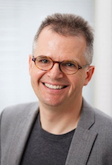


Prof. Harald W. Giessen
Harald Giessen (*1966) graduated from Kaiserslautern University with a diploma in Physics and obtained his M.S. and Ph.D. in Optical Sciences from the University of Arizona in 1995 as J.W. Fulbright scholar. After a postdoc at the Max-Planck-Institute for Solid State Research in Stuttgart he moved to Marburg as assistant professor. From 2001-2004, he was associate professor at the University of Bonn. Since 2005, he is full professor and holds the Chair for Ultrafast Nanooptics in the Department of Physics at the University of Stuttgart. He is also co-chair of the Stuttgart Center of Photonics Engineering, SCoPE. He was guest researcher at the University of Cambridge, and guest professor at the University of Innsbruck and the University of Sydney, at A*Star, Singapore, as well as at Beijing University of Technology. He is associated researcher at the Center for Disruptive Photonic Technologies at Nanyang Technical University, Singapore. He received an ERC Advanced Grant in 2012 for his work on complex nanoplasmonics. He was co-chair (2014) and chair (2016) of the Gordon Conference on Plasmonics and Nanophotonics. He was general chair of the conference Photonics Europe (Strasbourg 2018) and is co-chair of the biannual conference NanoMeta in Seefeld, Austria. He is on the advisory board of the journals "Advanced Optical Materials", "Nanophotonics: The Journal", "ACS Photonics", "ACS Sensors", and "Advanced Photonics". He is a topical editor for ultrafast nanooptics, plasmonics, and ultrafast lasers and pulse generation of the journal "Light: Science & Applications" of Nature Publishing Group. He is a Fellow of the Optical Society of America. In 2018, he was named „Highly Cited Researcher“ (top 1%) by the Institute of Scientific Information. His research interests include Ultrafast Nano-Optics, Plasmonics, Metamaterials, 3D Printed Micro- and Nano-Optics, Novel mid-IR Ultrafast Laser Sources, Applications in Microscopy, Biology, and Sensing.